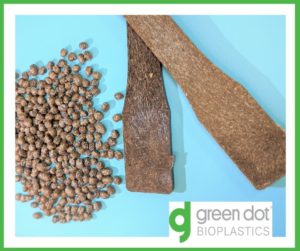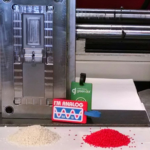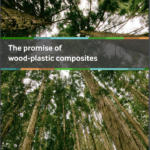Biocomposites: A Circular Economy Solution
What is a biocomposite?
Before we discuss biocomposites, let’s define how standard composites are utilized in the traditional plastics market. The plastics world has several types of widely used composite materials. By definition, a composite is a material made of 2 or more ingredients where each ingredient maintains its original form, but the two materials are combined to create some synergistic effect, usually stiffness or heat resistance. One of the materials in the composite is the polymer matrix and the other material is a fiber or filler. For example, the most common composites are fiberglass reinforced plastics (FRP). FRP, commonly called fiberglass, is made by combining glass fibers with epoxy resin to create a very stiff composite used in boat hulls, appliances, shower surrounds, etcetera. Glass fibers can be replaced with carbon fiber to create lightweight carbon fiber composites used in aerospace, bicycles, and high performance sports equipment. Carbon or glass fibers can also be combined with common thermoplastic resins, such as nylon or polypropylene, to make injection molded composite parts used in many under-the-hood applications such as fan shrouds, manifolds, fluid housings, or radiator end caps.
Biocomposites are simply an alternative composite where either the polymer matrix or the fiber and filler are derived from plants instead of petroleum. In some cases both the polymer matrix and the fiber or filler are plant derived and therefore more renewable and sustainable than traditional plastics, and can be carbon neutral. However, because there are so many available natural fibers and fillers which can be combined with a large variety of polymer matrices, the options for creating biocomposites are limitless.
Hemp, jute, flax, kenaf, and bamboo are all examples of common natural fibers that can replace glass or carbon to create more sustainable, plant based plastic, composite; additional fillers are wood, corn cob, and starch. Along with these common plant fibers, there are also many non-traditional plant byproducts from agriculture and forestry that can be used in biocomposites. Cellulose and polysaccharides from common wood processing or agricultural milling operations can provide many natural plant based fillers; with the added benefit that they are often the byproduct of some industrial process, and therefore divert a valuable resource away from the landfill contributing to circular economy initiatives and goals.
The mass balance is simple. If a manufacturer is using 100,000 pounds per year of traditional plastic in an application, and they replace it with a biocomposite containing 30% natural fiber or filler, they have reduced their plastic consumption by 30%, or 30,000 pounds. They have reduced fossil carbon consumption by 30% and reduced virgin material consumption by 30%.
Zero Waste
Achieving Zero Waste is an ambitious goal but critical to building a circular economy. By utilizing waste streams from forestry and agricultural processing we are able to up-cycle a wide variety of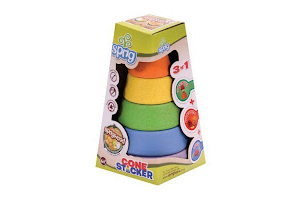 fibers and fillers. Another excellent option are traditional industrial processes. Furniture factories, sawmills, lumber makers, all produce a variety of natural cellulose fibers and fillers. These fibers and fillers can be reclaimed for the circular economy and put to use as a feedstock for new biocomposites. When these waste materials are reclaimed from a factory and diverted from the landfill, they can help companies achieve their zero waste goals.
fibers and fillers. Another excellent option are traditional industrial processes. Furniture factories, sawmills, lumber makers, all produce a variety of natural cellulose fibers and fillers. These fibers and fillers can be reclaimed for the circular economy and put to use as a feedstock for new biocomposites. When these waste materials are reclaimed from a factory and diverted from the landfill, they can help companies achieve their zero waste goals.
Picture a furniture factory that generates large volumes of saw dust from their milling operations. Those fibers can be reclaimed and used to make a biocomposite resin suitable for injection molded patio furniture, outdoor accessories, children’s toys, and a wide variety of other consumer products. In most cases, if you are using polypropylene or nylon today, you can move to a biocomposite with minimal changes to manufacturing.
When both the fiber and the polymer matrix are from reclaimed feedstocks, the results are truly zero waste, and truly circular. When reclaimed fibers and fillers are combined with reclaimed or recycled plastics to make a new biocomposite, the result is 100% reduction in virgin materials, 100% reduction in fossil carbon release, 100% landfill diversion.
Compostable Biocomposites
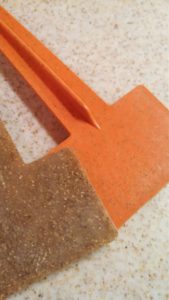 Plant based, natural fibers and fillers can be combined with any traditional bioplastic polymer matrix to create a compostable, biodegradable biocomposite. When those biocomposites meet the requirements for biodegradation within a certain timeframe (typically 180 days), and in a controlled environment, those biocomposites are considered compostable. They may be designated as either industrial compostable or home compostable depending on the test conditions.
Plant based, natural fibers and fillers can be combined with any traditional bioplastic polymer matrix to create a compostable, biodegradable biocomposite. When those biocomposites meet the requirements for biodegradation within a certain timeframe (typically 180 days), and in a controlled environment, those biocomposites are considered compostable. They may be designated as either industrial compostable or home compostable depending on the test conditions.
Natural fibers and fillers create enhanced pathways for water and oxygen to aid biodegradation in a composting environment and as a result compostable biocomposites will typically biodegrade faster than the same neat polymer with no filler added. This can be an advantage when trying to meet specific test requirements.
Many rigid packaging applications such as containers, vials, boxes, tubes, and cartons can benefit from a rigid material that is also fast biodegrading, or certifiable as home or industrial compostable. We have developed rigid biocomposites that maintain enough flexibility in thin walls to allow molding a living hinge such as in a clam-shell container.
Design Freedom
Biocomposites offer tremendous optionality for designers and marketers. It is possible to make biocomposites in any color, just like traditional petrochemical plastics. Fibers or fillers in the biocomposite can be highly visible, like you see in wood-plastic decking or park benches. Or the fibers and fillers can be completely invisible like the suspended solids in paint. It is possible to see individual discrete fibers embedded in the matrix, or achieve a more indistinguishable conglomerate look. It’s also possible to achieve a look where no individual fibers are visible at all. These options allow the designer to achieve the desired appearance while creating products that allow consumers to contribute to a more sustainable world.
Whether your product is a durable good intended for repeated use over many years or is single- use, a biocomposite very well could be the right material to achieve not only reduction in plastics usage but also to create market differentiation with a more natural aesthetic. On the store shelf, biocomposites using wood, hemp, corn cob, or other visible fillers are a difference your customer can see. A picture is worth a thousand words, biocomposites impower you to show the consumer you are committed to less plastics, a more circular economy, and are making a step toward Zero Waste.
To review data sheets for our Terratek® lines of Biocomposites, Natural Fiber Reinforced Plastics, or Biodegradable resins please visit the Materials Page.
Looking for additional information, these three papers provide more details about benefits and manufacturability of biocomposites.
Injection Molders Who Have Made Bioplastics Work
The Promise of Wood Plastic Composites
The Bioplastics Handbook for Injection Molders
Ready to discuss our material offerings? Please call our office or complete our contact form: www.greendotbioplastics.com/contact/


